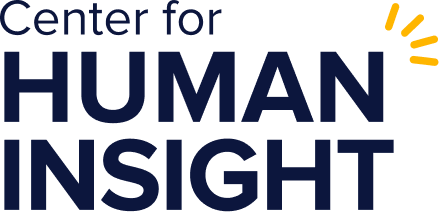
How to be a great consumer of human insights
Twelve tips on what to expect from experience research and how to partner with researchers, from an experience research guru

We all want to get closer to our customers, but sometimes it’s challenging to know when the right time might be to reach out to our research counterparts, what the right questions are, and how to fit the work into our busy production schedules. As a principal research strategist at UserTesting and lecturer in research techniques at the University of Michigan, I’ve dealt with hundreds of research teams and the employees who depend on them for insights. Here are my tips on how to become a better partner with your experience research team.
1. Be clear about the decisions you want to drive
Before you reach out to a research partner, understand how the research you are requesting fits into your business plans. Rather than checking the box that “research has been done,” think about what business outcome or decision will result from the insights you expect to receive. Ideally, you should ask for research that will drive a decision connected to a tangible, measurable goal – for instance, reducing the number of calls to the call center or increasing conversion from the product detail page.
2. Keep a list of every problem you find
Often, people worry that the small sample sizes in experience research mean the problems it uncovers are not significant. But if your website serves hundreds of thousands or millions of people, you can be guaranteed that every problem you find in experience research is affecting a significant number of people on the live site. While you might not address every single problem you uncover with research, you should catalog, prioritize, and acknowledge them to ensure you’re capturing all of the areas of opportunity that you have learned about.
3. Mitigate bias by asking people to describe what they perceive
It’s natural to want to know how people feel about the thing you’re testing. You want them to say they like it. Unfortunately, asking them directly to describe their feelings is a common source of bias in research, so you should not force the researchers in that direction. People naturally want to please each other. If you ask them how they feel, you might be priming them to report that they agree with your assessment or that they like it. Instead, good user research focuses on what people do and say. Researchers will use an objective way of measuring success of a design, such as, can people complete the task? They then ask them to describe the task or stimulus, and then check if the words they use align with the design intent. Why or why not? This is how you can learn about barriers and areas of opportunity to address.
4. Prioritize research that will make an impact now
Sometimes it can take a long time to gather and synthesize data for a large project, or access to the right participants may be a challenge. You need to satisfice. Do just enough research, sometimes with proxy users. Prioritize research that will inform highly risky decisions. Everything is not equally important, all of the time.
5. Ask for help to understand problems, not for “a survey”
It’s fine to negotiate with the researchers about the best way to understand a problem or area of opportunity. But don’t force them into a specific methodology. Describe the challenge or problem you would like to understand better and let the researcher guide you on how best to surface and present insights that will inform your decision-making.
6. Collaborate continuously and broadly
Build long-term relationships with colleagues across the organization to connect critical business outcomes to the research. A virtuous cycle of surfacing a need for answers and then measuring the success of the design solution requires that people in the product, research, and design teams must listen to one another continuously. This can include sharing data about the operations, inviting each other to critical meetings, and having hard conversations over coffee in informal settings or one-on-one to ensure that interoffice politics doesn’t prevent progress.
7. Create output that resonates with the team that needs to hear the message
Not every insight has to live inside of a 100-page report. If your team just needs a list of usability problems with examples so that people can determine how to address them, then ask for that output. Instead of a written report, you might also prefer to have a collaborative white board session where you review the data together to decide next steps. Collaborate with researchers to design the output or to curate an experience that the team needs to spur action and reflection. You might also create different documents or experiences that are tailored to the needs of unique teams who need to learn about the results of one study,
8. Spend some time watching customers react
Seeing is believing. There is no better way to understand research – how it is done, the trends and patterns that have surfaced, or exactly what participants said – than to spend time listening to and watching interview sessions. If the interviews are live, attend some of them. If the interviews are self-conducted, watch some of the recordings later. This does not have to be a full-time commitment; even watching one or two sessions or a one-minute highlight reel can teach you a lot about the seriousness of a usability issue.
9. Don’t over-focus on testing with customers
The biggest barrier to doing research is often finding participants. At times, you might be opening new markets where there are few customers. You might also have users who are hard to reach because of their busy schedules. Be open to feedback from proxy users, people who might become users, or – in cases where usability is not related to subject-matter expertise – feedback from anyone.
10. Measure and share impact across the org
Every project should have clearly defined goals and KPIs that measure success. This means that you should work to create a shared understanding of what research success looks like and what impact you expect to see in the operations of the business, whether you aim to drive efficiency or revenue.
11. Learn about research
Being an educated consumer of insights means that you should understand the methodologies or techniques that were used to collect the data. Spend the time learning about what researchers are doing to better connect with the insights and limitations that come with method selection.
12. Use research to challenge your assumptions
No one likes it when their work doesn’t hit the mark. But it’s far better to fail early, when you can readjust easily, than to have something hit the market and fail after a big investment of time and money. Test early and often. Reduce the risk of building the wrong thing by reaching out to customers to learn what is important to them. Reduce the risk of building it the wrong way by testing usability and the user experience at the prototype stage. Find opportunities to improve the current experience by testing your current experiences – and those of your competitors.
In this article

About The Center for Human Insight
We created this resource to help you use human insight for business decision-making.





